Searing does add a different dimension to tuna sashimi. We rather enjoyed this dish (a lot), which led to consuming more sake.
Monday, December 5, 2011
Seared or "aburi" fatty tuna トロの炙り
This is part of the tuna feast. Sometimes the fattiest part of tuna can be just a bit overwhelmingly too much fat for some (not for us). One of the ways to make the fattiness more agreeable is to use a technique called "aburi" 炙り. In the old days, charcoal fire was used but, nowadays, a kitchen torch is the most commonly used tool to accomplish this task. For this dish, I chose the fattiest portion of the tuna we had.
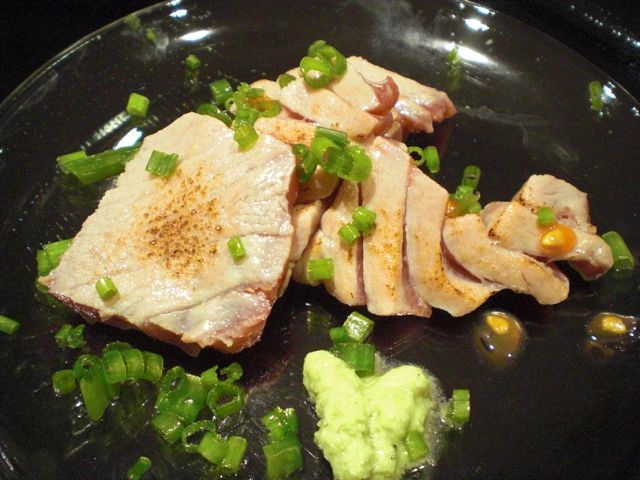 I placed the tuna slice on a plate and using a kitchen torch, I seared the sides of the tuna slices. I just served this with a garnish of chopped chives, fresh wasabi and soy sauce.
I placed the tuna slice on a plate and using a kitchen torch, I seared the sides of the tuna slices. I just served this with a garnish of chopped chives, fresh wasabi and soy sauce.
Saturday, December 3, 2011
Fatty tuna and scallion ネギトロ
Catalina offshore products did not have fresh tuna sashimi blocks for quite some time but, recently, it was back in stock. I ordered one pound along with other items. This is blue-fin tuna with "akami" and mostly "chu-toro" block which most likely came from a portion toward the tail.
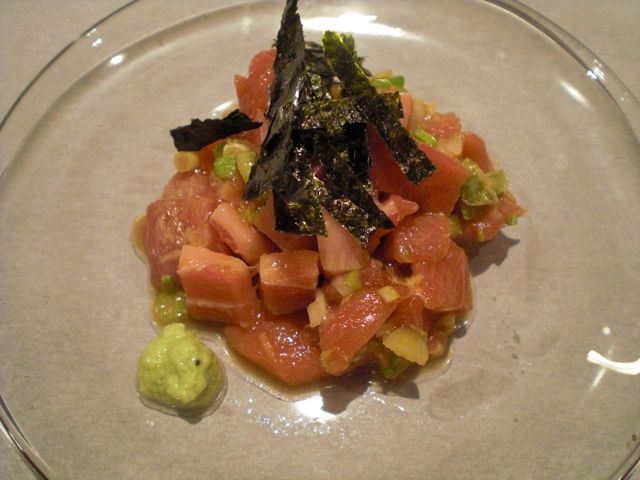 The one pound block looks like you see below with the skin still attached. Top triangular part is mostly red meat or "akami" 赤身 and underneath is mostly moderately fatty or "chu-toro" 中トロ and only small amount of fatty part or "toro" トロ. We got a much better block of tuna from them in the past but given the long hiatus in availability, I am not complaining.
The one pound block looks like you see below with the skin still attached. Top triangular part is mostly red meat or "akami" 赤身 and underneath is mostly moderately fatty or "chu-toro" 中トロ and only small amount of fatty part or "toro" トロ. We got a much better block of tuna from them in the past but given the long hiatus in availability, I am not complaining.

After I removed the skin and then the meat attached to the skin which was quite fatty (image above lower right). I decided to make "negitro" ネギトロ ("negi" means scallion and "toro" means fatty tuna) from this and other trimming or "scrap" parts. I then cut the akami by slicing horzontally (getting a triagular shaped akami block. I then divided the remaining rectangular blocks into slightly fatty ("ko-toro" and moderately fatty ("chutoro"). I wrapped each part in parchment paper, then paper towels and placed them in a Ziploc bag. I stored it in the meat drawer of the refrigerator, where it will keep up to 3 days if it is going to be used as sashimi. Any longer and it has to be cooked.
I am not sure where "negitoro" originally came from but I believe it was popularized by low-end shushi bars such as "Kaiten sushi" 回転寿司 place serving their customers utilizing scraps or low-quality tuna sashimi either as a roll or battle ship sushi or "gunkan maki" 軍艦巻き. Certainly, I did not have this while I lived in Japan. In any case, since I had thin but rather fatty meat (image above lower right) just off the skin, I made "negitoro". Since the portion was not totally scrap or scrapings from the skin or bone, I cut it into small dices rather than making it almost like paste which is usually the consistency of negitoro.
I just mixed in finely chopped scallion and dressed it with a mixture of "real" wasabi (just defrosted) and soy sauce and garnished it with nori strips. This was our starter for the tuna feast evening. The only problem with this type of dish is that you tend to over indulge with sake.
Thursday, December 1, 2011
Fried lotus root sandwich 蓮根のはさみ揚げ
Lotus root or "renkon" 蓮根 is a floating stalk of the lotus plant but is not really a root. It has air channels which makes it float on the water. Japanese (and Chinese) are fond of renkon which has a nice firm texture and is rather starchy. In the past, I could occasionally get fresh renkon in the Japanese grocery store but now only ones I can get are pre-boiled in a vacuum pack. That's just fine with me since it is always difficult to clean the insides of the air channels. The vacuum packed variety has a nice firm texture and can substitute for fresh ones for any dish which calls for renkon.
I served this with green tea salt. The renkon retains a nice crunchy texture which combined with the juicy meat stuffing is very nice. This dish will go with any drink including cold beer. Other variations could use chicken or shrimp for the stuffing. Of course, you can serve more than just one per person.
Pork: We had a whole pork loin which I made into three different kinds of roasts (Sino-Japanese pot roast, brined and non-brined pork roast cooked in the Weber with hot smoking) for Thanksgiving (we gave up on Turkey some years ago). I had some trimmings which I chopped by hand and made into ground meat. I decided to make this dish as a drinking snack. I am not sure about the amount but it was not a lot (may be less than 1/2 pound), just enough to make 7 sets of renkon sandwiches as see below.
Other ingredients for meat stuffing: I mixed in scallions (finely chopped, 3 stalks), grated ginger (1/2 tsp) and garlic (1/2 tsp), soy sauce (1/2 tsp) and mirin (1/4 tsp) and back pepper. I just kneaded the mixture together by hand until it became rather sticky. If it had too much moisture, I could add potato starch. I sliced the renkon into thin rounds (1/4 inch thick). I took a small amount of the meat mixture and made miniature hamburger patties the same size as the renkon rounds to form a sandwich (left in the image above).
Batter: I made a relatively thick tempura batter; a mixture of cake flour and potato starch (3:1) and ice cold water.
I coated the renkon sandwiches with the batter and deep fried in 340F peanut oil for 2-3 minutes turning once or until the meat was done.
I served this with green tea salt. The renkon retains a nice crunchy texture which combined with the juicy meat stuffing is very nice. This dish will go with any drink including cold beer. Other variations could use chicken or shrimp for the stuffing. Of course, you can serve more than just one per person.
Tuesday, November 29, 2011
Japanese omelet with Cod roe wrapped in nori 鱈子と海苔いりだし巻き
This is a dish I made from the cod roe left over after I made nagaimo dressed with cod roe. I posted a similar dish before but this time I wrapped the cod roe with a nori sheet before making it to a Japanese style rolled omelet. Again, I could have done a better job of centering the nori/cod roe.
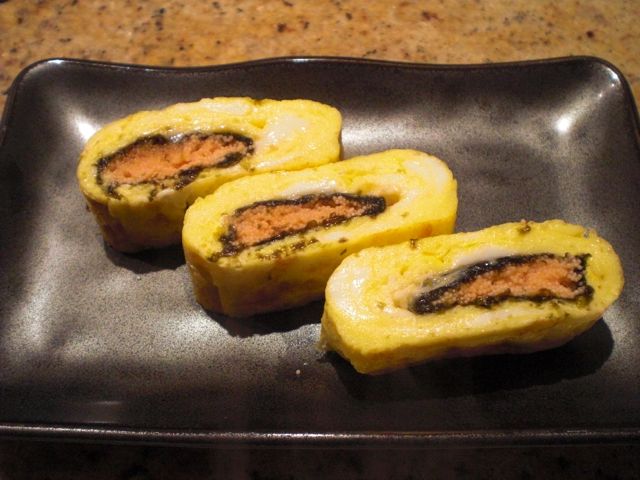
The cod roe is about a half a sack mixed with sake and Tabasco. I just cut the nori sheet to the width of the square frying pan I used to make the Japanese omelet. I put the cod roe in the center of the nori sheet and rolled it to make a rather flat roll (image below left).
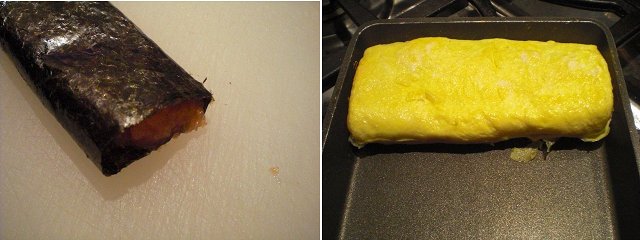
I cut it into 6 pieces (3 for one serving). The cod roe was just barely cooked and was lovely and moist. The addition of nori makes the rolling easier as well as adding a nice oceanic flavor to this dish. The tabasco gave it a slight zing. Of course, the egg part is slightly sweet and dashi adds nice soft texture and delicate flavor. There is no need for soy sauce since cod roe gives enough saltiness. The winning combination! We, of course, had cold sake with this.
I just mixed two beaten eggs with dashi broth (2 tbs) and added sugar (2 tsp) and salt (a pinch). On medium heat, I put a small amount of vegetable oil (1 tsp) and poured in 1/4 of the egg mixture. When the bottom is set, I placed the cod roe/nori roll on the far side of the pan and started rolling using a spatula, Japanese cooking chop sticks and by tilting the pan to help with the rolling. I poured another 1/4 of the egg mixture into the open area of the pan, lifting the existing omelet so that the egg mixture flows under it. I rolled again and repeated the process until all the egg mixture was used resulting in a rectangular omelet (image below right).
Sunday, November 27, 2011
Nagaimo dressed in cod roe 長芋の鱈子和え
This is a small dish which goes perfectly with sake. This was again made from odd bits and pieces of left overs in the refrigerator which I try to use before they go bad. In particular I was concerned about one sack of cod roe or "tarako" 鱈子 which I bought the previous weekend and had been sitting forlornly in the refrigerator ever since. I posted few dishes using cod roe. I also found half a nagaimo 長芋 also left in the fridge and this is a quick dish I came up with. This is a sort of variation of this dish.
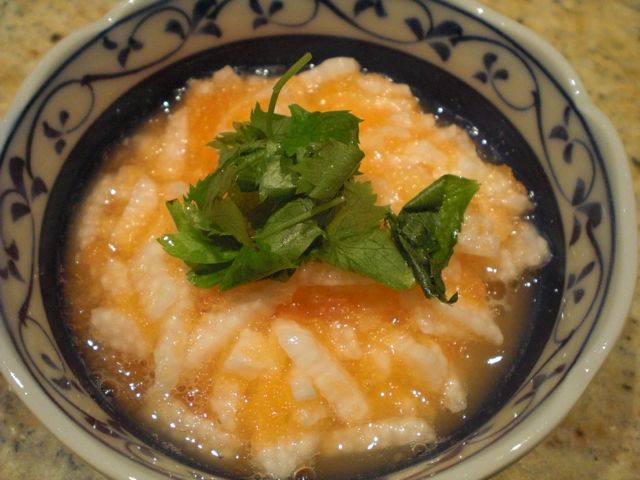
I first removed the roe from the sac by cutting a slit in the membrane and using the back of he knife, scraping off the roe. I added sake and Tabasco to make it a softer but not a too slushy consistency.
I also happened to have "mitsuba" 三つ葉, a Japanese green with a distinct favor. I removed the leaves from the stem and used it as a garnish. Unfortunately, this one did not have much flavor.
I peeled and sliced the nagaimo into thin disks (1/4 inch), halved, then, and cut into short match sticks. I dressed them with sushi vinegar. I drained the excess sushi vinegar from the nagaimo by lifting the nagaimo into another container. I added enough cod roe to make a nice mixture and mixed it into the magaimo (The remaining code roe was used for other dish).
I also happened to have "mitsuba" 三つ葉, a Japanese green with a distinct favor. I removed the leaves from the stem and used it as a garnish. Unfortunately, this one did not have much flavor.
This dish is a perfect small dish to start off the evening with cold sake. Tabasco added nice heat but was not too hot. The dish had an interesting texture and nice saltiness. This one has to be eaten with a spoon even if you are chopsticks jedi.
Friday, November 25, 2011
Sautéed octopus, mixed mushroom in sherry sauce 蛸ときのこのシェリー酒ソース
This is another octopus dish which could be served at an Izakaya. Since I used Fino sherry this could be considered in the Spanish style. Again, this was made totally on a whim in the moment and there is no recipe on which this is based. Since I had leftover mixed mushroom (white and brown clam shell and Royal trumpet mushrooms), which I bought a few days ago, and green asparagus, this is the dish I came up with as a starter.
 The octopus was slightly chewy but had a nice texture. Reduced sherry added a good nutty flavor, although this sherry is extremely dry you could also taste a very slight sweetness. The freshly ground black pepper gave a nice contrast. This dish will go with any drink but we had this with another classic Napa cab, Rudd "Crossroad" 2006 (75% cabernet sauvignon, 14% cabernet franc, 7% merlot, and 2% each petit verdot and malbec). This is the second label of Rudd estate. It is highly extracted with lots of upfront back fruit (black cherry, blueberry etc.) and nice vanilla and dark chocolate notes ending in firm tannin with a long finish. This dish went well with this wine.
The octopus was slightly chewy but had a nice texture. Reduced sherry added a good nutty flavor, although this sherry is extremely dry you could also taste a very slight sweetness. The freshly ground black pepper gave a nice contrast. This dish will go with any drink but we had this with another classic Napa cab, Rudd "Crossroad" 2006 (75% cabernet sauvignon, 14% cabernet franc, 7% merlot, and 2% each petit verdot and malbec). This is the second label of Rudd estate. It is highly extracted with lots of upfront back fruit (black cherry, blueberry etc.) and nice vanilla and dark chocolate notes ending in firm tannin with a long finish. This dish went well with this wine.
The amounts of these ingredients are all arbitrary. I had a leftover boiled octopus leg which I cut into about 12 thin slices (for two small servings). I also used green asparagus (4, After I removed and discarded the bottom parts, I cut the bottom half into thin slices on a slant and left the tips intact), garlic (two fat cloves finely minced). I removed the root ends of the clam shell mushrooms (not much whatever amount I had) and tore the royal trumpets along the length of the mushrooms in 4-5 pieces (one large)
I first sauteed the garlic and asparagus in a frying pan on medum flame with olive oil (1 tbs) for several minutes and added mushrooms. After the mushrooms were mostly cooked and soft, I added the octopus slices and sauteed for 30 seconds. I seasoned it with salt and cracked black pepper and added Fino sherry (3 tbs, or any dry sherry). I turned up the flame and quickly reduce the liquid. I added more freshly ground black pepper after I plated the dish for good measure.
I may have been a bit too heavy on the black pepper since my wife somehow inhaled it (this was meant to be tasted and eaten not inhaled) but nice black pepper taste was needed in this dish.
Wednesday, November 23, 2011
Octopus with tomato and olive イタリア風 たこ、トマト、黒オリーブ煮
I bought a boiled octopus leg at the Japanese grocery store on the weekend but I did not use it. I thought I should use it for something before it goes bad. I usually make Japanese dishes from octopus but this evening, we had already opened a bottle of "Bennett family Cabernet Sauvignon 2006". This wine will not go well with "sumiso-ae" 酢みそ和え. So, I concocted this dish; sort of Italian in style but I did not follow any recipe or I did not have any dish in mind to base this one on.

Octopus: The tentacle was medium in size, just boiled but not previously vinegared. I just sliced it rather thinly. To prevent it from getting too tough during cooking, I made shallow scores on one side.
 In a small skillet, I added olive oil (3 tbs) on low flame and added the garlic, red pepper flakes and slowly cooked it until the garlic became fragrant and very slightly brown. I added the tomatoes, chopped black olive, salt, and pepper. I turned up the heat to medium and cooked for 2-3 minutes (This is not really a tomato sauce). I then added slices of octopus and cooked for 30 more seconds or just until warm--not really cooking it further. I cut the heat and tasted it. I adjusted the seasoning by adding salt and a pinch of sugar since I thought it was a bit on the acidic side. I was thinking of adding lemon juice but changed my mind and only added grated lemon zest (using a micrograter) to give it a lemony flavor. I garnished with chopped parsley (If I had fresh thyme, I may have used thyme). My wife quickly toasted some bread (store bought semolina bread) for mopping up the juice.
In a small skillet, I added olive oil (3 tbs) on low flame and added the garlic, red pepper flakes and slowly cooked it until the garlic became fragrant and very slightly brown. I added the tomatoes, chopped black olive, salt, and pepper. I turned up the heat to medium and cooked for 2-3 minutes (This is not really a tomato sauce). I then added slices of octopus and cooked for 30 more seconds or just until warm--not really cooking it further. I cut the heat and tasted it. I adjusted the seasoning by adding salt and a pinch of sugar since I thought it was a bit on the acidic side. I was thinking of adding lemon juice but changed my mind and only added grated lemon zest (using a micrograter) to give it a lemony flavor. I garnished with chopped parsley (If I had fresh thyme, I may have used thyme). My wife quickly toasted some bread (store bought semolina bread) for mopping up the juice.
I decided on making a quick tomato sauce "on the fly". So I skinned Campari tomatoes (4) and cut them into large chunks. I crushed and minced garlic (2 fat cloves). I removed the stone from black olives (6 or so, I am not sure what kind).
 In a small skillet, I added olive oil (3 tbs) on low flame and added the garlic, red pepper flakes and slowly cooked it until the garlic became fragrant and very slightly brown. I added the tomatoes, chopped black olive, salt, and pepper. I turned up the heat to medium and cooked for 2-3 minutes (This is not really a tomato sauce). I then added slices of octopus and cooked for 30 more seconds or just until warm--not really cooking it further. I cut the heat and tasted it. I adjusted the seasoning by adding salt and a pinch of sugar since I thought it was a bit on the acidic side. I was thinking of adding lemon juice but changed my mind and only added grated lemon zest (using a micrograter) to give it a lemony flavor. I garnished with chopped parsley (If I had fresh thyme, I may have used thyme). My wife quickly toasted some bread (store bought semolina bread) for mopping up the juice.
In a small skillet, I added olive oil (3 tbs) on low flame and added the garlic, red pepper flakes and slowly cooked it until the garlic became fragrant and very slightly brown. I added the tomatoes, chopped black olive, salt, and pepper. I turned up the heat to medium and cooked for 2-3 minutes (This is not really a tomato sauce). I then added slices of octopus and cooked for 30 more seconds or just until warm--not really cooking it further. I cut the heat and tasted it. I adjusted the seasoning by adding salt and a pinch of sugar since I thought it was a bit on the acidic side. I was thinking of adding lemon juice but changed my mind and only added grated lemon zest (using a micrograter) to give it a lemony flavor. I garnished with chopped parsley (If I had fresh thyme, I may have used thyme). My wife quickly toasted some bread (store bought semolina bread) for mopping up the juice.
For an instant improvised dish, this was not bad at all. The octopus slices were tender and not chewy. The red pepper flakes gave a pleasant buzz in your mouth. Even some acidity did not complete with the red wine we were having. This cab from the Bennett family winery is a middle of the road Napa cab, not over-the-top and not too austere.
Subscribe to:
Posts (Atom)




